Day 8: Sept 4 Abu Simbel
The officially sponsored tour for Abu Simbel had filled up, but we were able to join with a fellow couple of passengers and do a private trip from Aswan to Abu Simbel by car. We had an early breakfast.
And then met our hired car. We got to glimpse the dam that had forced them to move Abu Simbel in the 1960s.
Driving through the desert is an interesting experience for a short while, but eventually settles into routine.
Midway through the trip we turned into a little rest stop. It reminded me a little of stops we had made in the Mexican desert. It was a nice protection from the sun, had a lot of tile and a fountain that was not running. A group of men hung out and chatted lazily and you got the feeling that this was how they spent their days. I imagine it was busier in high tourist season, but it was a reminder to me that life could be slower and satisfying even in such an inhospitable hot desert clime.
The geography changed when we arrived in the city of Abu Simbel.
There were mounds that looked like possible pyramids as we got closer to Abu Simbel.
Here is the welcome sign.
We pulled into the site and immediately had a lovely view of the river.

For younger readers it may help to mention that the entire site was moved in the 1960s because the building of the big Aswan damn threatened the submersion of these two major temples constructed by Ramses II.

Unesco spearheaded the project which took place between 1964 and 1968 and cut everything into big blocks (averaging 20 tons each and some weighing as much as 30 tons) and transported them to a higher location 200 meters back from the river.
The entire site was raised 65 meters higher.
We arrived eventually after a three hour drive. After getting out of the car, all you see at first is lake Nasser, but then as you curve around a bend you see the temples.
It was so exciting as I got closer to see these monumental structures that dominated the news when I was growing up.
Here is a wikipedia photo by Per Olow showing the rebuilding of the huge statues of Ramses II.
Our guide showed us some important things to look for in the temples using photos.
...and then he set us free to go explore.
Nothing can really give the sense of grandeur, but this little statue of Nefertari at the feet of one the Ramses Colossi and the statues of Horus capture a bit of the size difference. The facade is 33 meters high
...and if you look carefully you can see a row of sun worshipping baboons sitting along the top of the temple.
As you enter the large temple, you see these images of captured Nubian soldiers. They seem to wear feathers like the Native American warriors.
The large temple is in honor of Ra-Horakhty, the falcon-headed version of the god of the rising and setting sun (seen below between the central colossi.) Its "proper" name is the "Temple of Ramesses II beloved of Amun." The statue of Ra-Horakhty which is above the entrance to the temple has reliefs of Ramses honoring him on either side
The interior of the tomb is laid out like this:
The entry to the grand temple has a hypostyle hall of eight Osirid figures of the pharaoh (Ramses in his deified form). The figures on the right show the King wearing the double crown of Upper and Lower Egypt.
Somehow they do not look as majestic as the statues we saw at other locations such as Karnak and Luxor. These figures on the right as you enter the temple wear the combined crown of Upper and Lower Egypt.
The figures on the left side of the temple in contrast wear only the single crown of Upper Egypt.
It is a little hard to distinguish, but the flat topped crown of Lower Egypt is not depicted on the figures of the left, while the combined crown is on the figures of the right.
Inside the temple are many reliefs of Ramses making offerings to the gods. Here he holds a plate of offerings for Re-Horakhty. (found on the third column left)
Here he offers flowers (and perhaps bread) to the crocodile god Sobek (second column left).
This seems to be Ramses II holding nemset jars before the deified version of himself.
This (above) may be Ramses making an offering to Ptah.
This can give a sense of how the pillars relate to the images on the walls.
Ramses II is of course also shown smiting his enemies, the Syrians, the Nubians and the Hittites.
The walls depict the intricate story of Ramses II's foray into Syria and the Gaza area against the Hittite King Muwatalli.
This chariot scene features the Battle of Kedash. Much is known about this exciting battle and I invite you to read the whole story here. Some highlights are Ramses' invasion of Hittite land in order to regain once Egyptian-held lands. As he approached the Hittite camp two spies lied and told him the Hittites were far away. Ramses only had one division (the Amun division) with him, so he called for the Ptah and Ra divisions to come, despite Hittite prisoners soon after spilling the beans to Egyptian forces, the Ra division was surprised by the Hittites, who were able to disperse most of Ramses' immediate forces. The Hittite enemy foolishly decided to plunder the Egyptian camp, however, rather than finishing the job and King Ramses managed a surprise counter attack that sent the Hittites fleeing northward. Hittite heavy chariots though were no match for the lighter weight Egyptian vehicles and thus Ramses was able to procure an amazing victory against great odds. The whole story is depicted on the Northern wall
We have the story from a variety of sources including letters found on clay tablets and texts on the wall of the Ramesseum temple.
As you proceed into the temple you come to the inner sanctum which has four statues: Ptah, Amun-Ra, RamsesII as a god, and Re-Horakhty.
The smaller Temple has giant statues of Nefertari and Ramses at equal height and is dedicated to the cow goddess Hathor.
It has a footprint that looks like this:
These statues are not quite as large as those of Ramses on the other temple, but it is still impressive, especially since Nefertari is featured so prominently.
Nefertari looks quite regal in her double-plumed headdress.
As you enter the smaller temple you see the heads of Hathor with her cow ears on the six columns supporting the roof.
The scenes on the pillars are Nefertari and Ramses II making offerings to various gods. The ceiling contains a text in which Ramses dedicates the temple to Queen Nefertari.

At the back of the pronaos are three doors that lead to another chamber.

One of the most impressive reliefs is this image of Nefertari flanked by Hathor and maybe Isis (or maybe just two Hathors).

This is another lovely image of flowers being presented to the goddess Hathor on a barque.
The time flew by and soon it was time to make the three hour drive back to Aswan.
On the way out we walked around the back of the temples just out of curiosity.
It gave us a chance to view the monuments from the other direction.
Of course there were more souvenir stands on the way out.
By this time I had decided that the only other thing I wanted was an aventurine necklace, and mostly we were being approached by people with t-shirts, scarves and picture books. One gets a bit weary from all the attention, I must say.
And then with relief it was back into the car and...
...onward again through the desert.
I won't deny that we were very tired and slept a good portion of the trip.
And the desert passed by and we got back late afternoon and had a late lunch.
The day ended with a port talk as usual.
And then another outstanding dinner from our Chef.
We were all tired after another exciting day.
And there was music in the evening if we had any energy left... but spousal unit D and I were off to bed because we knew we would be leaving the ship at 8 AM the next morning to see Philae and the Nubian village.


























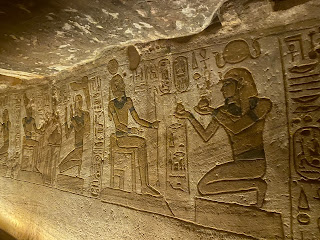
















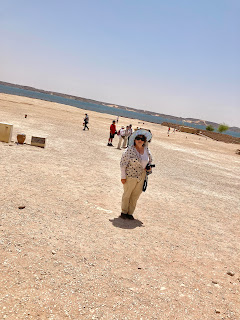



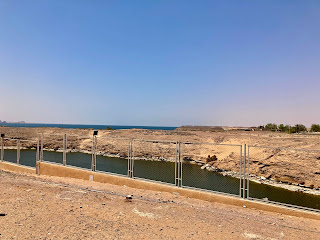


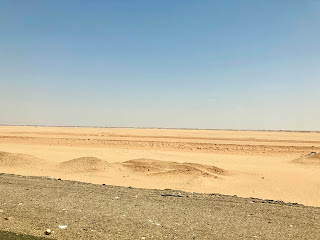




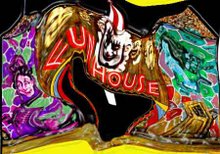

No comments:
Post a Comment